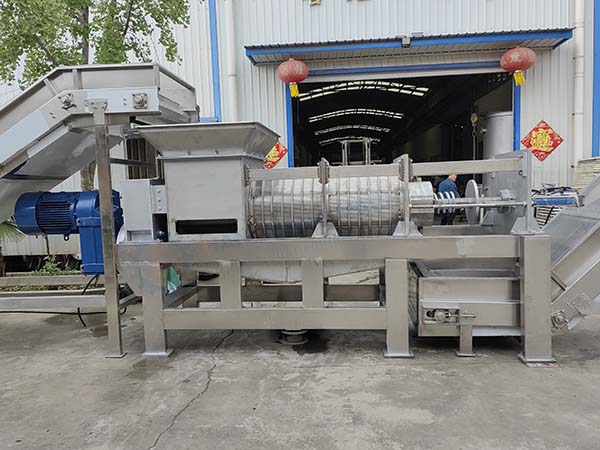Organic waste dewatering machine
Contents |
[edit] Introduction
In the realm of waste management innovation, the fruit and vegetable waste dewatering machine emerges as a transformative solution, effectively reducing waste volume and environmental impact. This cutting-edge equipment employs a straightforward yet highly efficient mechanical squeezing mechanism, swiftly eliminating moisture from fruit and vegetable waste, positioning it as a pivotal tool for modern waste processing.
[edit] Working Principle
At its core, the screw dewatering machine relies on the mechanical compression of waste material to expedite the removal of moisture. This process not only significantly decreases the weight of the waste but also reduces its volume, marking a substantial leap forward in waste management efficiency.
[edit] Processing Workflow
The operational workflow of the machine encompasses several key steps, including feeding, dehydration, and residue discharge. As fruit and vegetable waste is introduced into the machine, an internal screw squeezing mechanism efficiently removes moisture. The residue discharge outlet then expels the remaining solid waste, completing a comprehensive and streamlined processing cycle.
[edit] Advantages
1. High Efficiency and Energy Conservation
The adoption of mechanical compression accelerates the dehydration process, achieving remarkable efficiency within a short time frame. Simultaneously, the liquid solid separation equipment minimises energy consumption, aligning with modern energy-efficient practices and contributing to a more sustainable operational model.
2. Volume Reduction
By effectively dehydrating fruit and vegetable waste, the machine significantly reduces the volume of waste, making it more manageable for subsequent processing and transportation. This reduction in volume not only improves logistical aspects but also contributes to a lighter environmental footprint.
3. Environmental Protection
Dehydrated fruit and vegetable waste are more easily managed and prone to decomposition, reducing the risk of soil and water pollution. This aspect of the machine's functionality is crucial for creating a cleaner and healthier ecological environment, aligning with global environmental preservation goals.
4. Recyclability
The reduced moisture content in dehydrated waste enhances organic material concentration, providing an optimal foundation for the production of organic fertilrers. This process fosters a closed-loop system, emphasising the recycling and reuse of resources, thereby contributing to a more circular and sustainable economy.
[edit] Operating Guidelines
1. Adherence to Standard Operating Procedures:
Operators must be well-versed in the correct usage of the equipment to ensure its smooth operation and the effective processing of fruit and vegetable waste. Strict adherence to standard operating procedures is fundamental to maximising the machine's potential.
2. Regular Maintenance:
Routine inspections and maintenance routines are essential to uphold the proper functioning of the dewatering machine. This proactive approach not only ensures the longevity of the equipment but also contributes to sustained operational efficiency.
3. Safety Precautions:
In the course of operation, strict adherence to safety measures is imperative. This ensures the well-being of operators, preventing injuries, and guarantees the secure and reliable operation of the equipment.
[edit] Conclusion
In conclusion, the fruit and vegetable waste dewatering machine represents a significant leap forward in waste management technology, offering an efficient, environmentally friendly, and sustainable solution for processing fruit and vegetable waste. Its innovative design, multifaceted advantages, and commitment to operational excellence make it an invaluable asset in the global effort towards responsible waste management and resource conservation.
- = Related articles on Designing Buildings =
- Anaerobic digestion.
- Biomass.
- Biogas.
- Circular economy.
- Composting.
- Disposal.
- Environmental impact assessment EIA.
- Reduce, reuse, recycle.
- Recycling explained
- Site Waste Management Plans – A Necessary Burden.
- Types of fuel.
- Waste and Resources Action Programme WRAP.
- Waste hierarchy.
- Waste management plan for England.
- Wishcycling.
- Working with lighting maintenance contractors.
- Anaerobic digestion.
- Biomass.
- Biogas.
- Natural resource.
Featured articles and news
Government consultations for the summer of 2025
A year of Labour, past and present consultations on the environment, the built environment, training and tax.
CMA competitiveness probe of major housing developers
100 million affordable housing contributions committed with further consultation published.
Homes England supports Greencore Homes
42 new build affordable sustainable homes in Oxfordshire.
Zero carbon social housing: unlocking brownfield potential
Seven ZEDpod strategies for brownfield housing success.
CIOB report; a blueprint for SDGs and the built environment
Pairing the Sustainable Development Goals with projects.
Types, tests, standards and fires relating to external cladding
Brief descriptions with an extensive list of fires for review.
Latest Build UK Building Safety Regime explainer published
Key elements in one short, now updated document.
UKGBC launch the UK Climate Resilience Roadmap
First guidance of its kind on direct climate impacts for the built environment and how it can adapt.
CLC Health, Safety and Wellbeing Strategy 2025
Launched by the Minister for Industry to look at fatalities on site, improving mental health and other issues.
One of the most impressive Victorian architects. Book review.
Common Assessment Standard now with building safety
New CAS update now includes mandatory building safety questions.
RTPI leader to become new CIOB Chief Executive Officer
Dr Victoria Hills MRTPI, FICE to take over after Caroline Gumble’s departure.
Social and affordable housing, a long term plan for delivery
The “Delivering a Decade of Renewal for Social and Affordable Housing” strategy sets out future path.
A change to adoptive architecture
Effects of global weather warming on architectural detailing, material choice and human interaction.
The proposed publicly owned and backed subsidiary of Homes England, to facilitate new homes.
How big is the problem and what can we do to mitigate the effects?
Overheating guidance and tools for building designers
A number of cool guides to help with the heat.
The UK's Modern Industrial Strategy: A 10 year plan
Previous consultation criticism, current key elements and general support with some persisting reservations.
Building Safety Regulator reforms
New roles, new staff and a new fast track service pave the way for a single construction regulator.

























